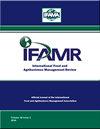到处都一样吗?德国南部两个区域蔬菜生产集群的竞争力
IF 1.5
4区 经济学
Q3 AGRICULTURAL ECONOMICS & POLICY
International Food and Agribusiness Management Review
Pub Date : 2022-08-18
DOI:10.22434/ifamr2021.0119
引用次数: 0
摘要
德国蔬菜生产的特点是栽培蔬菜作物品种繁多。不同产区在气候条件、农场结构和销售基础设施方面也存在很大差异。德国南部两个最重要的蔬菜生产区是所谓的“大蒜之乡”,位于弗兰科尼亚中部,以及巴伐利亚南部的露天生产区。这两个蔬菜产区虽然在地理上相距不远,但在地域大小、历史发展、生产范围等方面存在明显差异。本文根据波特的产业集群定义和他的钻石模型,分析了两个蔬菜产区的竞争力。应用这种方法,竞争力由四束决定因素指定,即要素条件,当地需求条件,可用的支持产业以及竞争类型和战略。集群概念强调了不同决定因素之间相互作用的重要性,除了现有的网络和竞争力之外,它还有助于确定改善框架条件的可能选择。因此,对于集群利益相关者如何减轻不利条件等弱点,并进一步结合其优势以提高长期竞争力,得出了实际意义。本文章由计算机程序翻译,如有差异,请以英文原文为准。
Everywhere the same? Competitiveness of two regional vegetable production clusters in Southern Germany
German vegetable production is characterized by its pronounced variety of cultivated vegetable crops. There are also large differences among distinct production regions in terms of climate conditions, farm structures and marketing infrastructure. Two of the most important vegetable production regions in Southern Germany are the so-called ‘Knoblauchsland’ (Garlic Country) in Middle Franconia and the open-field production region in Lower Bavaria. Although these two vegetable production regions are geographically not far apart, they show distinct differences in size of the region, their historical development, and different scope of production. This paper analyzes the competitiveness of the two vegetable production regions following Porter’s definition of industry clusters and his Diamond model. Applying this approach, competitiveness is specified by four bundles of determinants, namely factor conditions, local demand conditions, available supporting industries, and type of rivalry and strategies. The cluster concept emphasizes the importance of the interplay of the different determinant bundles and, in addition to the existing networks and competitiveness, it also helps identify possible options for improvements of the framework conditions. Thus, practical implications have been derived on how cluster stakeholders can mitigate weaknesses such as unfavorable conditions, and further combine their strengths to increase competitiveness in the long term.
求助全文
通过发布文献求助,成功后即可免费获取论文全文。
去求助
来源期刊

International Food and Agribusiness Management Review
AGRICULTURAL ECONOMICS & POLICY-
CiteScore
2.90
自引率
0.00%
发文量
0
审稿时长
>12 weeks
期刊介绍:
The IFAMR is an internationally recognized catalyst for discussion and inquiry on issues related to the global food and agribusiness system. The journal provides an intellectual meeting place for industry executives, managers, scholars and practitioners interested in the effective management of agribusiness firms and organizations.
IFAMR publishes high quality, peer reviewed, scholarly articles on topics related to the practice of management in the food and agribusiness industry. The Journal provides managers, researchers and teachers a forum where they can publish and acquire research results, new ideas, applications of new knowledge, and discussions of issues important to the worldwide food and agribusiness system. The Review is published electronically on this website.
The core values of the Review are as follows: excellent academic contributions; fast, thorough, and detailed peer reviews; building human capital through the development of good writing skills in scholars and students; broad international representation among authors, editors, and reviewers; a showcase for IFAMA’s unique industry-scholar relationship, and a facilitator of international debate, networking, and research in agribusiness.
The Review welcomes scholarly articles on business, public policy, law and education pertaining to the global food system. Articles may be applied or theoretical, but must relevant to managers or management scholars studies, industry interviews, and book reviews are also welcome.
 求助内容:
求助内容: 应助结果提醒方式:
应助结果提醒方式:


